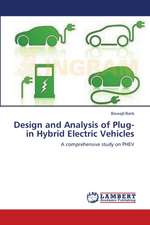Automotive Painting Technology: A Monozukuri-Hitozukuri Perspective
Editat de Kimio Toda, Abraham Salazar, Kozo Saitoen Limba Engleză Hardback – 21 dec 2012
The book will bring readers up to date on progress in the field over the last decade to provide a basis for and to indicate fruitful directions in future R&D and technology innovation for automotive painting.
| Toate formatele și edițiile | Preț | Express |
|---|---|---|
| Paperback (1) | 1014.96 lei 38-44 zile | |
| SPRINGER NETHERLANDS – 23 aug 2016 | 1014.96 lei 38-44 zile | |
| Hardback (1) | 1254.24 lei 6-8 săpt. | |
| SPRINGER NETHERLANDS – 21 dec 2012 | 1254.24 lei 6-8 săpt. |
Preț: 1254.24 lei
Preț vechi: 1529.56 lei
-18% Nou
240.02€ • 249.17$ • 200.14£
Carte tipărită la comandă
Livrare economică 22 martie-05 aprilie
Specificații
ISBN-10: 9400750943
Pagini: 212
Ilustrații: XI, 184 p.
Dimensiuni: 155 x 235 x 17 mm
Greutate: 4.62 kg
Ediția:2013
Editura: SPRINGER NETHERLANDS
Colecția Springer
Locul publicării:Dordrecht, Netherlands
Public țintă
ResearchCuprins
Textul de pe ultima copertă
The book will bring readers up to date on progress in the field over the last decade to provide a basis for and to indicate fruitful directions in future R&D and technology innovation for automotive painting.
Caracteristici
Descriere
This book offers unique and valuable contributions to the field. It offers breadth and inclusiveness. Most existing works on automotive painting cover only a single aspect of this complex topic, such as the chemistry of paint or paint booth technology. Monozukuri and Hitozukuri are Japanese terms that can be translated as “making things” and “developing people” but their implications in Japanese are richer and more complex than this minimal translation would indicate. The Monozukuri-Hitozukuri perspective is drawn from essential principles on which the Toyota approach to problem-solving and continuous improvement is based. From this perspective, neither painting technology R&D nor painting technology use in manufacturing can be done successfully without integrating technological and human concerns involved with making and learning in the broadest sense, as the hyphen is meant to indicate. The editors provide case studies and examples -- drawn from Mr. Toda’s 33 years of experience with automotive painting at Toyota and from Dr. Saito’s 18 years experience with IR4TD, the research-for-development group he leads at the University of Kentucky -- that give details on how these two principles can be integrated for successful problem-solving and innovation in industry, in university R&D, and in the collaboration between the two.
The book will bring readers up to date on progress in the field over the last decade to provide a basis for and to indicate fruitful directions in future R&D and technology innovation for automotive painting.




















